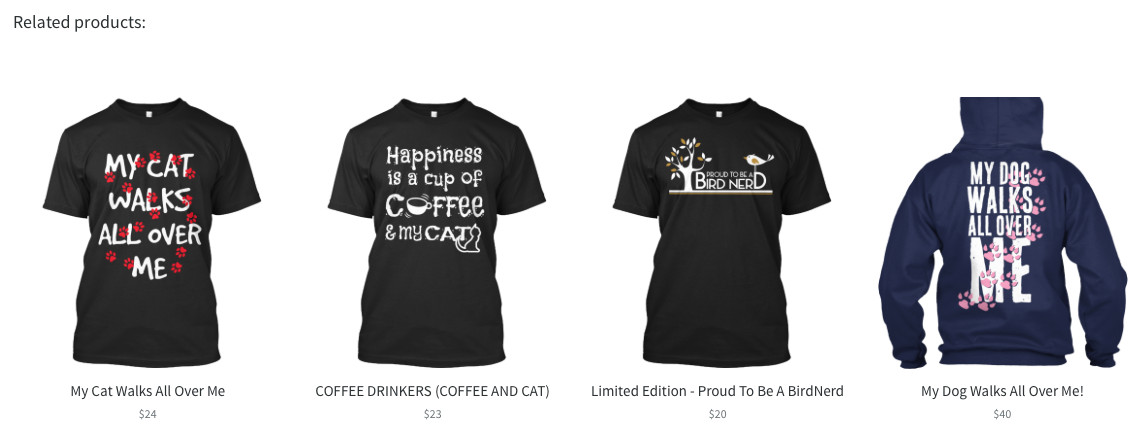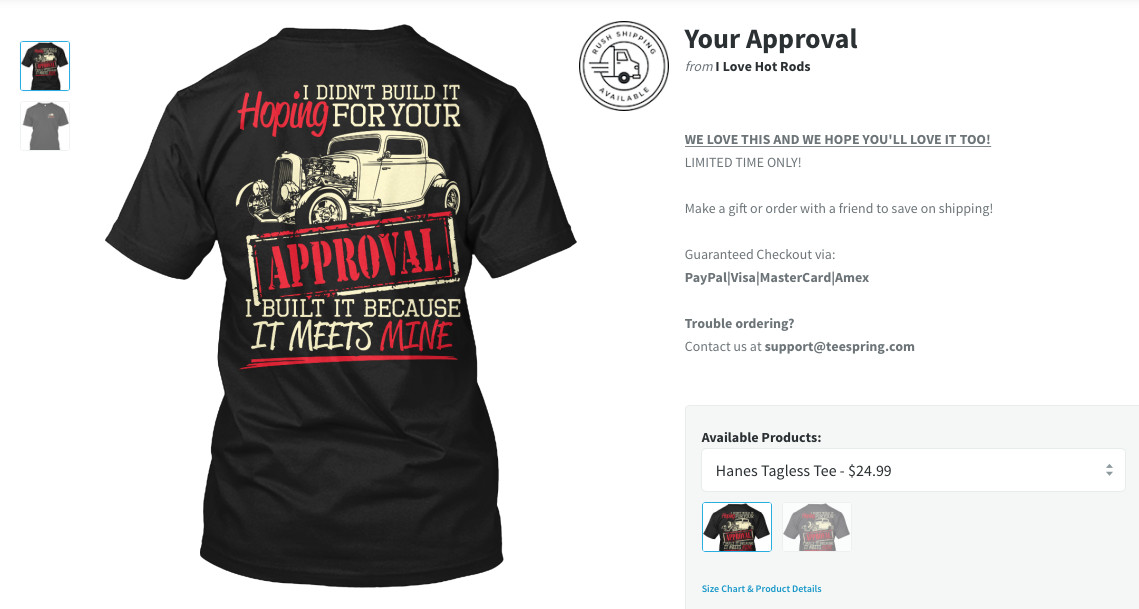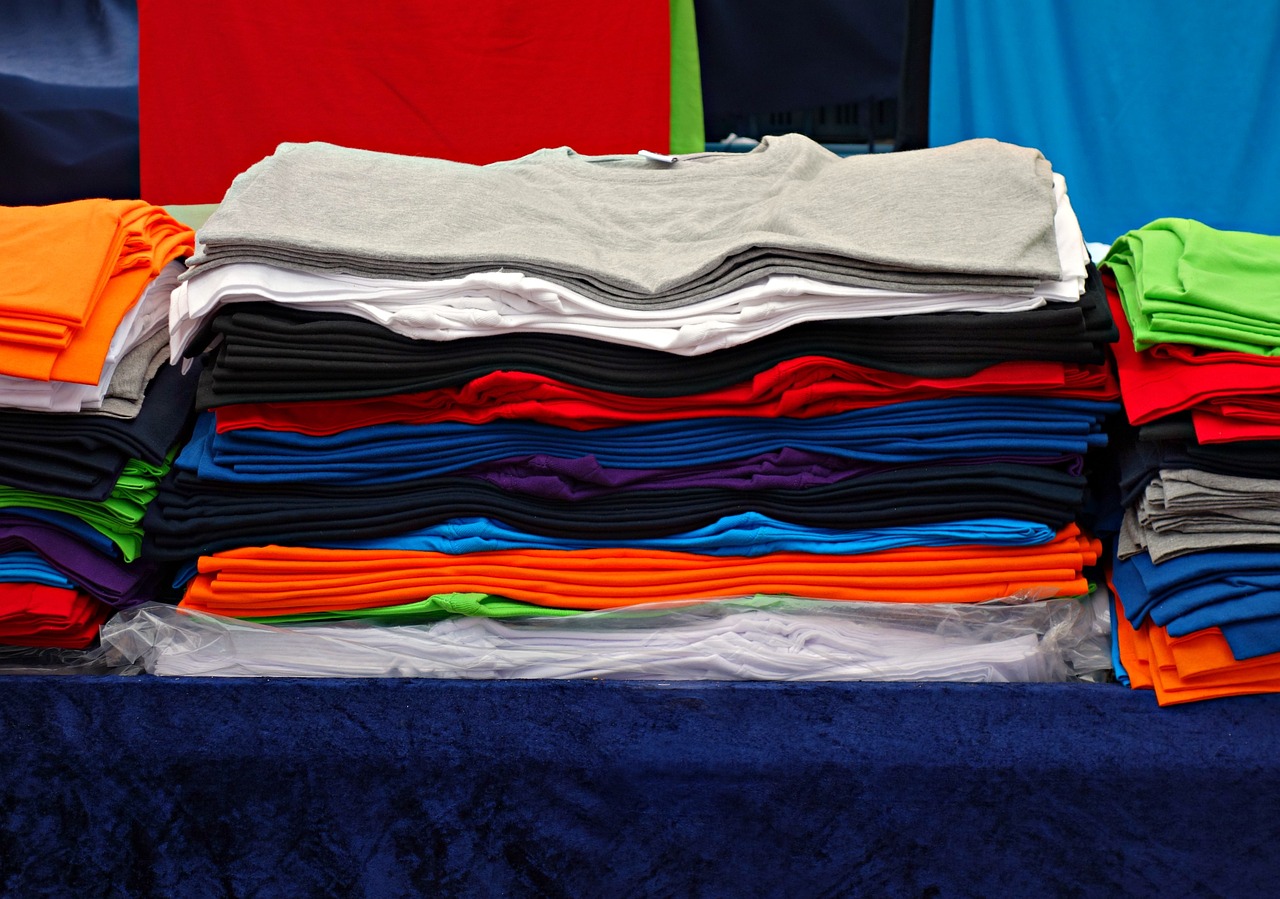
Selling on T-Shirt Fulfilment Platforms vs Your Own Brand Website
Even though you are running an online business, this doesn’t necessarily mean you can forget all about either start up or operating costs. When it comes to running a t-shirt selling business, there are two main routes that can be taken. Either having their own online store built, often a long and painstaking process, or taking the easy route by piggy-backing on order fulfillment services.
Many newcomers to the t-shirt business start with fulfillment platforms because it takes a lot of the risk out of their hands. These services are typically little to no cost to you and have you upload an image to be purchased and produced. It also greatly reduces startup costs, which can really make or break a new business. But on the other hand, it also means giving up a significant amount of control to others and it can be insanely competitive to get your designs off of the ground.
An important consideration is whether you have the experience and resources to run your own show. Although selling through these platforms can take over a lot of your business, that may not be such a bad thing if you’ve never opened a shop before or want to test out a new brand.
Starting platforms such as TeeSpring or Spreadshirt can be beneficial if you have shirt designs, but don’t know what to do with them, or you don't want to be too heavily committed. If you're happy to stay a small shirt company or side-hustle, these platforms are often the best route.
Yet, easier in business isn’t always necessarily better. While setting up and running a shop wholly owned and operated by you can mean a lot of sleepless nights, it can also be the best choice in the long run. If you really want to grow into an apparel brand and not just a fly-by-night tee shirt seller, you'll want to consider shaking off these chains.
You may even cosndier building a business than leverages the best of both worlds by having your own dedicated website, while having your orders taken care of by a fulfillment service on the backend.
If you are still unclear on the best route to start, or the next step to take with your business, here are some key considerations for selling on t-shirt platforms or your own webstore.
Your Shirts May Not Be Technically “Yours”
No matter how easy a fulfillment website might make it for you to sell your designs, the full ownership of the designs often stops belonging to you when you use them. And this doesn’t just apply to shirt designs, either; when you run your shop through their site, they get the final say on every little detail.
If you can’t stand the design of your virtual storefront, either from it looking confusing and being hard to use, or you can’t stand the colors that they use, tough – your store is their store. And this problem worsens when it comes to pricing – they may have your designs so underpriced that it may quickly stop being worth it to make them.
Or if you’re planning on reaching a wider audience, they may only ship to certain countries or even certain regions. They may not print shirts in certain languages as a quality control stance, or they may not serve the groups who speak a particular language that you had planned on selling to. By limiting your prices, your customer reach, and even how your shop looks, it stops feeling like “your” business at all.
Another limiting factor that you’ll be hit with is the types of shirts you will have designs printed on. If you planned on printing on a high quality, premium shirt, or at the very least, something better than paper-thin, you’re going to be restricted to their particular range. At the end of the day, a shirt’s material is just as important as the design on it, and if you can’t control that it will only hurt you as a brand.
Fulfillment Sites Are One-Size-Fits-All
To be perfectly honest, the majority of shirt fulfillment sites use similar styling and layouts. What's more, your “store” is going to look almost identical to the next seller on your platform. And as an online store owner, that’s a problem – when your store looks almost identical to thousands of others, how are you supposed to gain any traction? Sure, they give you some choices to customize your store, but not enough to truly make it stand out. And from a creative perspective, if your store looks generic, people will think your designs are just as bland.
Say lightning does decide to strike and you’ve got a hot design that’s really selling. What’s preventing someone else with the same-looking shop from ripping off your design? Heck, what if the site themselves decide to rip off your design? You won’t have a whole lot of options.
When you don’t control your design, you can’t control who uses them. And when you can’t control that, you’re at the mercy of hoping that nothing bad happens to it. If you want your designs to be owned and protected by you, you’re going to need your own shop.
Your Designs Will Need Approval
When you make a design and try to upload it to a platform, it has to first be approved for printing on a strictly functional basis; will the design print out legibly? And the process can seemingly take forever to approve your shirt for screening.
“No big deal,” you’ll say. “I’ll just upload some more, that way they all get approved around the same time.” Not so fast; these sites generally have a cap as to how many designs you can upload at once. So while you may have an entire notebook of designs ready to go, you may only get to pick out a couple for now. And considering you don’t have any inventory up and running yet, this is extra time ticking away that you aren’t making money.
Chances are, since they take your design and slap it on multiple different surfaces, they’re going to require that you use a vector image. That’s all well and good, assuming you actually know how to do that. And if you don’t, that’s another time-consuming hurdle that you’ll have to figure out. Once you’ve finally learned how, your may come to the realization that your coolest designs aren’t going to fly, because they only print in three colors, and black and white are two of them.
There may also be other creative differences as well. If your shirts are a bit too profane or risqué, they probably aren’t going to approve them. This can be especially problematic if you were planning on having an edgier brand.
Who's Really Getting the Benefit From SEO?
If you know a thing or two about SEO, you can leverage different methods to drive more traffic directly to your website or store. Whereas, if you are selling from another platform, all your hard work may also be driving visitors to your competitors!
Many of these t-shirt platforms already receive tonnes of traffic, perphaps 500,000 visitors daily. This may even be used to entice you, but what they won’t tell you is each individual shop has little to no search engine presence. So if you expect to build a customer base through SEO, you should really be focusing on your own website or store, not theirs!
Creditability as a “Real” Brand
Do you know how many kids sit around the cafeteria table, bang out a dumb inside joke, and then throw it up on a tee shirt site? Now imagine your designs are on the same hosting platform; do you really think you’re going to have a shred of credibility as a brand when they’re literally right next door? This may not be a deal breaker if your designs are being made for nothing but laughs and if you make a few bucks, even better. But any designer or budding brand worth their salt needs their own shop. Besides, a custom site is going to look infinitely more professional, and not like a hobbyist or amateur.
Having a real online store is effective for several reasons. First, it just looks more like “you” and not a generic template that a million other designers are using. You have more control over inventory, descriptions, and even site design choices. Not to mention your own site won’t be flooded with annoying ads; free to use fulfillment sites are going to have ads that you won’t be able to turn off, hide, or simply move to somewhere else on the page.
Another item that will help boost your credibility and image is your domain. Rather than being shirtmaker5000.shirtshop.com/free, you’ll have your own domain and URL that best reflects you. And when you don’t have a goofy URL, customers just may take you seriously.
Some of these fulfillment sites look like they haven’t had an update in a decade. The fonts are atrocious and hard to read, other design factors are simply outdated and even laughable. And to think, you and your designs are going to be a part of this. It only hurts your image at the end of the day, and if you want to look the part of “professional”, you need a professional site.
Convience Comes With Increased Costs
So maybe they offer an option to turn on ads for an additional fee. Or maybe they’ll let you change your URL for an added fee. Or offer SEO with extra fees. Basically, if you want your free shop to not look, and act, like a free shop, it isn’t going to be free at all.
They’ll try to sweeten the deal to keep you walking; they’ll offer things like paying X amount of dollars gives you additional shops, or additional language options, or even email newsletters. But a lot of these types of options either come with a more professional site, or are affordable enough to use a third party for. By paying for your own site, you may actually save money on these add-ons.
And then there’s the payment issue. A lot of fulfillment sites make you hold off on collecting your money until you’ve reached a certain sales threshold. That means that even though you have sales, you still can’t touch the money you’ve earned. And then, when you finally can make a withdrawal, they’re going to take their cut out of it. Suddenly that big payday you were expecting isn’t all that big at all.
Consider this; how are you going to advertise a shop that doesn’t belong to you, and offers zero SEO options? That issue alone makes your own private store worth it. In order to make a website worth the cost, it has to be able to be advertised, and if you can’t do that, even if it’s free, it’s not really worth your time. Even if you pay more for your “free” site, it’s still not going to give you the visibility you need to succeed.
There are a lot of good reasons to sell through a fulfillment platform, but that doesn’t mean it’s the best choice for what you’re trying to accomplish. Even though fulfillment sites offer an easy way to get your foot in the door, it’s probably not going to work out for your specific needs in the long term. If you’re really looking to make a name for yourself, you’re going to have to pay them more to make your site functional, and at that point, you may as well simply buy your own site. When you have more control over your business and its designs, you’ll probably be a happier designer anyways.
So what are your thoughts on owning your own website vs. selling on fulfillment platforms? What has worked for you? Let us know how it worked for you down in the comments. Let us know what your preferred method is and why.






